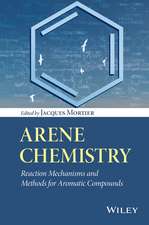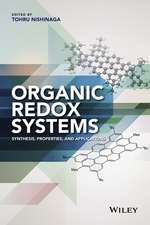Macrocyclic Polyether Syntheses: Reactivity and Structure: Concepts in Organic Chemistry, cartea 13
Autor G. W. Gokel, S. H. Korzeniowskien Limba Engleză Paperback – 10 dec 2011
Din seria Reactivity and Structure: Concepts in Organic Chemistry
- 15%
 Preț: 637.93 lei
Preț: 637.93 lei - 15%
 Preț: 638.57 lei
Preț: 638.57 lei -
 Preț: 402.76 lei
Preț: 402.76 lei -
 Preț: 388.13 lei
Preț: 388.13 lei -
 Preț: 400.65 lei
Preț: 400.65 lei - 18%
 Preț: 721.63 lei
Preț: 721.63 lei -
 Preț: 378.71 lei
Preț: 378.71 lei -
 Preț: 378.71 lei
Preț: 378.71 lei - 15%
 Preț: 641.53 lei
Preț: 641.53 lei -
 Preț: 380.84 lei
Preț: 380.84 lei - 15%
 Preț: 636.45 lei
Preț: 636.45 lei - 15%
 Preț: 650.37 lei
Preț: 650.37 lei - 15%
 Preț: 640.08 lei
Preț: 640.08 lei -
 Preț: 387.75 lei
Preț: 387.75 lei - 15%
 Preț: 640.06 lei
Preț: 640.06 lei -
 Preț: 387.20 lei
Preț: 387.20 lei -
 Preț: 380.84 lei
Preț: 380.84 lei - 15%
 Preț: 639.08 lei
Preț: 639.08 lei - 15%
 Preț: 639.08 lei
Preț: 639.08 lei -
 Preț: 381.81 lei
Preț: 381.81 lei -
 Preț: 382.57 lei
Preț: 382.57 lei -
 Preț: 395.25 lei
Preț: 395.25 lei - 15%
 Preț: 642.83 lei
Preț: 642.83 lei - 15%
 Preț: 643.34 lei
Preț: 643.34 lei -
 Preț: 378.54 lei
Preț: 378.54 lei - 15%
 Preț: 636.45 lei
Preț: 636.45 lei - 20%
 Preț: 546.18 lei
Preț: 546.18 lei - 15%
 Preț: 638.43 lei
Preț: 638.43 lei
Preț: 650.19 lei
Preț vechi: 764.93 lei
-15% Nou
Puncte Express: 975
Preț estimativ în valută:
124.42€ • 133.04$ • 103.73£
124.42€ • 133.04$ • 103.73£
Carte tipărită la comandă
Livrare economică 18 aprilie-02 mai
Preluare comenzi: 021 569.72.76
Specificații
ISBN-13: 9783642684531
ISBN-10: 364268453X
Pagini: 436
Ilustrații: XVIII, 412 p.
Dimensiuni: 170 x 244 x 23 mm
Greutate: 0.69 kg
Ediția:Softcover reprint of the original 1st ed. 1982
Editura: Springer Berlin, Heidelberg
Colecția Springer
Seria Reactivity and Structure: Concepts in Organic Chemistry
Locul publicării:Berlin, Heidelberg, Germany
ISBN-10: 364268453X
Pagini: 436
Ilustrații: XVIII, 412 p.
Dimensiuni: 170 x 244 x 23 mm
Greutate: 0.69 kg
Ediția:Softcover reprint of the original 1st ed. 1982
Editura: Springer Berlin, Heidelberg
Colecția Springer
Seria Reactivity and Structure: Concepts in Organic Chemistry
Locul publicării:Berlin, Heidelberg, Germany
Public țintă
ResearchCuprins
1. Introduction and General Principles.- 1.1 Background.- 1.2 Pedersen’s Discovery of Crown Compounds.- 1.3 Nomenclature and Jargon.- 1.3.1 Crown Ether.- 1.3.2 Azacrown.- 1.3.3 In-Out Bicyclic Amines.- 1.3.4 Cryptands and Cryptate Complexes.- 1.3.5 Lariat Ethers.- 1.3.6 Crown Esters.- 1.3.7 Spherands.- 1.3.8 Cascades.- 1.3.9 Polypodes and Octopus Molecules.- 1.3.10 Host-Guest-Chemistry.- 1.3.11 Conventions.- 1.4 The Cyclooligomerization of Ethylene Oxide.- 1.5 Polyazamacrocycles as Complexing Agents for Transition Metals.- 1.6 References.- 2. The Template Effect.- 2.1 Introduction.- 2.2 Operation of the Template Effect.- 2.3 Evidence for the Template Effect.- 2.4 Complexation Constants and the Template Effect.- 2.5 References.- 3. Syntheses of Oxygen Macrocycles.- 3.1 Pedersen’s First Crowns.- 3.2 Syntheses of 18-Crown-6.- 3.3 Syntheses of Dibenzo and Dicyclohexano-18-Crown-6.- 3.4 Synthesis of Substituted Benzocrowns.- 3.5 Crowns Incorporating the Xylylene Unit.- 3.6 Furan-containing Macrocycles.- 3.7 Crowns Containing the Paracyclophanyl Unit.- 3.8 Bis-Crowns.- 3.9 Lariat Ethers.- 3.10 Miscellaneous Crown Systems.- 3.11 Ne wkome’s Pyridine-containing Macrocycles.- 3.12 Okahara’s One-pot Approach.- 3.13 Chiral Crowns.- 3.13.1 Cram’s Chiral Binaphthyl Systems.- 3.13.2 Crowns Incorporating the Tartaric or Lactic Acid Subunit.- 3.13.3 Crowns Incorporating Sugar Subunits.- 3.14. Organometallic Derivatives of Crowns.- 3.15 Cesium Salts in Crown Synthesis.- 3.16 Listings of Tables.- 3.17 Tables 3.1–3.29.- 3.18 References.- 4. Syntheses of Azacrowns.- 4.1 Introduction.- 4.2 Monoazacrowns.- 4.3 Bridged Monoazacrowns.- 4.4 Diazacrowns.- 4.5 Cyclams.- 4.6 Cyclic Oximes.- 4.7 Macrocyclic Imines.- 4.8 Thioazamacrocycles.- 4.9 Biologically Active Azacrowns.- 4.10 CrownEther Based Dyes.- 4.11 Newkome’s Pyridine-containing Macrocycles.- 4.12 Listing of Tables.- 4.13 Tables 4.1–4.21.- 4.14 References.- 5. Crown Esters and Macrocyclic Polyether Lactones.- 5.1 Introduction.- 5.2 General Ester Synthesis.- 5.3 Macrocyclic Ester Properties.- 5.4 One-pot Macrocyclic Lactone Synthesis.- 5.5 The Hantzsch Condensation.- 5.6 Antibiotic Models.- 5.7 Stannoxanes as Covalent Templates.- 5.8 Macrocyclic Esters by Ozonolysis.- 5.9 Photochemical Macrocyclization.- 5.10 Listing of Tables.- 5.11 Tables 5.1–5.14.- 5.12 References.- 6. Miscellaneous Macrocycles.- 6.1 Macrocyclic Polyether Acetals.- 6.2 Macrocyclic Thioethers.- 6.2.1 Simple Sulfur Macrocycles.- 6.2.2 Macrocycles with Sulfur-containing Subunits.- 6.2.3 Macrocyclic Polysulfides.- 6.3 Mixed Sulfur-Nitrogen Macrocycles.- 6.4 Phosphorus and Arsenic-containing Macrocycles.- 6.5 Silicon-containing Macrocycles.- 6.6 Polymer-bound Macrocycles.- 6.6.1 Pendant Crown Polymers.- 6.6.2 Crown Ether Copolymers.- 6.6.3 Polycrowns.- 6.6.4 Pseudocrowns.- 6.7 Listing of Tables.- 6.8 Tables 6.1–6.4.- 6.9 References.- 7. Open-chained Equivalents of Crown Ethers.- 7.1 Introduction.- 7.2 Uses of Open-chained Equivalents in PTC.- 7.3 Octopus Molecules.- 7.4 Substituted Podands.- 7.5 Synthetic Ionophores.- 7.6 Listing of Tables.- 7.7 Tables 7.1–7.13.- 7.8 References.- 8. Cryptands and Related Poly cyclic Systems.- 8.1 Inception and General Syntheses.- 8.2 Cryptands Containing Sulfur and Nitrogen in the Bridges.- 8.3 Lipophilic Cryptands.- 8.4 Cryptands Containing a Carbon Bridgehead.- 8.5 Chiral Cryptands.- 8.6 Miscellaneous Cryptands.- 8.7 Macropolycyclic Cryptands.- 8.8 Polymer-bound Cryptands.- 8.9 listing of Tables.- 8.10 Tables 8.1–8.5.- 8.11 References.- Author Index.






